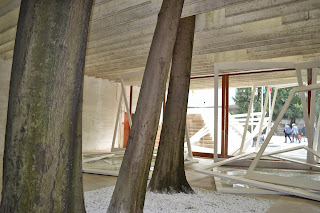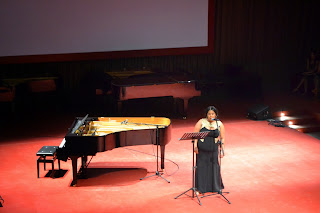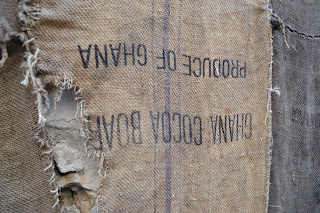Story and photos by Dwight Casimere
VENICE, ITALY--The 2015 Venice La Biennale world art exhibition will go down in history as the first and most prominent display of black art on a global scale. Under the direction of internationally reknowned curator, art critic, editor and writer Okwui Enwezor, Director of the Visual Arts Sector, the exposition, rather than gathering diverse forms and practices into a unified vision, is informed by by a constellation of parameters. Entitled All The World's Futures, the exposition encompasses a layering of three intersecting filters. Okwui Enwezor, Curator of the 56th International Art Exhibition addressed the global media at a news conference at the opening ceremony. He described the theme as "a layering of three intersecting filters, namely Garden of Disorder, Liveliness: On Epic Duration and Reading Capital. These three filters are touched upon in order to imaging and realize a diversity of practices." The result is an exhibition that not only employees the historical trajectory of the Biennale itself, while also describing the current state and appearance of things in the world. "Delving into the contemporary global reality creates a stage where historical and counter-historical projects will be explored," Enwezor explained. "These projects, works and voices, like an orchestra, will occupy the spaces of the Biennale and pre-occupy the time and thinking of the public that view them."
The exhibition occupied the whole of the City of Venice and its environs. Each of the pavilions erected by the countries of the world, encompassed their own themes and central artist conceptions. The Nordic Pavilion, for example, featured the work of Camille Norment, a Black American artist who is a native of Silver Spring, Maryland, who now lives and works in Oslo, Norway. Her project, 'Rapture,' encompasses a site-specific sculptural and sonic installation in the Nordic Pavilion, couple with live performances by the artist and her trio with David Topp, a composer with the London College of Communication in an abstract 'performance lecture' encompassing the spoken word, voice and sound vibration along with Swedish soprano and voice-artist/improviser Sofia Jernberg. The Camille Norment Trio involves both traditional and historical instruments, including electric guitar, the Hardanger fiddle and the glass armonica, a legendary 18th century instrument that creates ethereal music using glass and water. The glass armonica was first celebrated for curing people with its entrancing music. Invented by Benjamin Franklin, and once played by Mozart and Masrie Antoinette, the glass armonica was later banned because it was though to arouse sexual excitement in women. It is used with new music composed by the artist to explore the relationship between the human body and sound. Norman has created a multi-sensory space which reflects the history of sound, contemporary concepts of harmony and dissonance and the water, glass and light that is unique to Venice. Combing sound, sculpture and architectural stimuli, Normant's installation is one of the most striking of all of the international pavilions.
Situated between the pavilions of the United States and Denmark, the Nordic Pavilion is centrally situated on one of the main arteries of the Giardini, la Biennale's central locale. 'Rapture' by Camille Norment is especially notable because this year, Norway is solely responsible for the Nordic Pavilion at the Venice Biennale for the first time in history. So significant was this event, that Herr Royal Highness Crown Princess Mette-Marit of Norway presided over the official inauguration, with an address by Curator of the Nordic Pavilion, Kayla Garcia-Anton, Director of OCA and a performance by the Camille Norment Trio followed by a news conference and reception.
When entering the Nordic Pavilion, one is at first awe-struck by the cultural installation Shattered Glass by Camille Norment, which features huge World Trade Center-sized window frames, surrounded by huge shards of broken glass, that are actually carefully crafted pieces that were individually crafted by architectural designers. Inside, viewers are bathed in natural light and surrounded by a sonic chorus of recorded voices and sounds from the ancient armonica. Central to the pavilion are three large trees thrusting through the roof of the pavilion to the sky. The pavilion was deliberately built around the trees to heighten the relationship of the space and its occupants to its natural surroundings in the Giardini.
In talking about her installation 'Rapture,' Camille Norment commented: "Sound, by its nature, permeates borders-even invisible ones. Throughout history, fear has been associated with the paradoxical effects music mason the body and mind and its power as a reward-giving de-centraliser of control. Music is still seen by many in the world as an experience that should be controlled-especially in relation to the female body-and yet it is also increasingly used as a tool for control, especially under the justifications of war."
In addition to Camille Norment's commission for the primary installation at the Nordic Pavilion, the 56th Venice International Art Exposition is notable for its involvement of African, African American and artists of color from around the world.
Besides the appointment of Okwui Enwezor as Curator, award-winning Ghanaian-born, British architect David Adjaye is the designer of the ARENA, a large-scale venue designed to bring together practitioners across the fields of visual arts, cinema, music, theatre, dance and performance art. "The entire project took six months of planning and nearly two years of execution and building,"Adjaye confided in an interview. The ARENA is being introduced as something new to La Biennale, in that this is an active space dedicated to continuous programming across all disciplines. It's especially unique because it is located within the Central Pavilion of the Giardini, making it the virtual heartbeat of the entire Biennale" Ghanaian born British filmmaker and filmmaker Isaac Julien has curated and directed DAS KAPITAL, in which trained actors read a dramatic text from the writings and philosophy of Karl Marx for the entire duration of La Biennale from now through November 22, 2015. Accompanying the live reading from Marx;s seminal and still-controversial book, a classic of social and economic analysis, the readings will be accompanied by a continuous sequence of other oral performances, involving the spoken word, librettos, lyrics and scripts from noted artists around the world.
Award-winning jazz artist and composer Jason Moran of New York City has curated a series of live performances at the ARENA entitled STAGED, which maps and investigates the tempos of songs sung in prisons, fields and houses. A sampling of songs by inmates working in Angola Louisiana State Penitentiary, women clapping hands to the rhythm of a plow while toiling in the fields and work songs sung on the docks or in urban factories, provides the tapestry of spoken and verbal sound that is the fabric of the ARENA.
Camille Norment of Oslo in the Norway Pavilion with her armonica and (Below) "Shattered Glass"
Camille Norment's armonica
The installation at the Russian Pavilion
"Shattered Glass" in the Nordic Pavilion
A tree grows through the roof of the Nordic Pavilion
Jason Moran's "Work Songs" in the ARENA
Early morning in St. Mark'sSquare
ARENA designer David Adjaye
Scenes from the work fields at Angolo Prison
Sunset over the Grand Canal
Above and Below: Scenes from the film installation by Acadamy Award winning director Steve McQueen of "Twelve Years A Slave"


































No comments:
Post a Comment